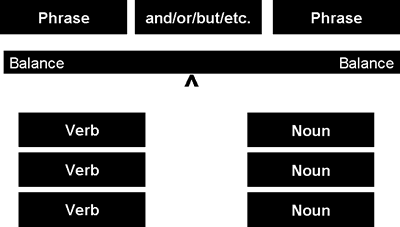Parallel structures are a particularly powerful way to communicate information because they create structural repetitions that emphasize and connect ideas. In grammatical terms, two structures are parallel if they have the same grammatical form (both verbs or both nouns, for example). These parallel items or ideas are often coordinated as items in a list.
Identifying lists that are not presented in parallel is much more difficult for writers than for the readers of their work. Writers know how their ideas relate and tend not to notice when points are not parallel. Without parallel structures, readers may fail to recognize how ideas connect and may be confused by what they read. The following diagram illustrates the patterns for parallel sentence structure.

Ideas within sentences that are joined by coordinating conjunctions (and, but, or, nor, for, yet, or so) must also be parallel. For example, gadgets and gizmos are joined by coordinating conjunctions in each of the following phrases. These structures are appropriately parallel because the items coordinated are the same part of speech (i.e., gadgets and gizmos are both nouns):
both gadgets and gizmos
not gadgets, but gizmos
neither gadgets nor gizmos
either gadgets or gizmos
The following lists the most commonly used ways of indicating that two or more ideas are coordinated. When these coordinators appear in a sentence, the pairs or lists of items they connect must have the same grammatical form.
- and
- or
- as well as
- rather than
- neither... not
- either... or
- not only... but also
- Use the same verb form when linking ideas together using a coordinating conjunction.
- Split excessively long sentences in two to avoid parallelism problems.
- Repeat prepositions in lengthy prepositional phrases.
- Try to balance length as well as structure.
- Ensure lists are parallel by starting all items with nouns or verbs.
- Avoid mixing complete sentences and sentence fragments in lists.
- Beware of Microsoft’s automated features!